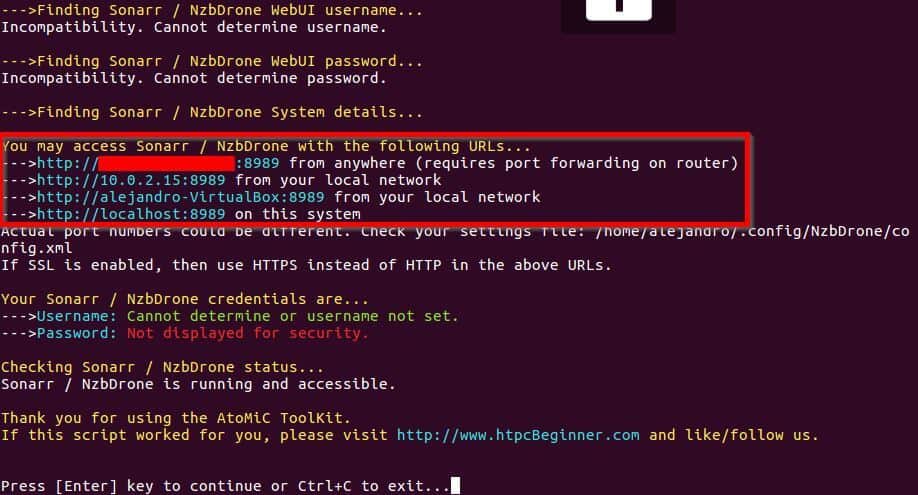

- #INSTALL SONARR ON RPI WORKING HOW TO#
- #INSTALL SONARR ON RPI WORKING INSTALL#
- #INSTALL SONARR ON RPI WORKING UPDATE#
- #INSTALL SONARR ON RPI WORKING SOFTWARE#
- #INSTALL SONARR ON RPI WORKING PASSWORD#
If you want to start RPCWI automatically when the Raspberry Pi boots, use the autostart item to enable this option.įigure 6: The app supports motion detection and a range of options. RPCWI runs on port 80, so if you already have web applications installed on the Raspberry Pi, you need to reconfigure RPCWI to run on a different port – the apache_port option allows you to do that. Next, select apache_security, type yes in the Enable field, specify the desired username and password, then hit OK ( Figure 2).
#INSTALL SONARR ON RPI WORKING PASSWORD#
This might not be a big issue if your Raspberry Pi sits on a local network behind a firewall, but if the machine is accessible from the web, it would be prudent to enable password protection. That means everybody can view the live video feed, take photos, record videos, and perform other supported actions. By default, anyone can freely access your RPCWI instance. RPi_Cam_Web_Interface_Installer.shĪnd use the configure menu item to display the available configuration options.
#INSTALL SONARR ON RPI WORKING INSTALL#
You'll then be prompted to reboot the Raspberry Pi, and once you've done that, RPCWI is ready to go.įigure 1: A dedicated graphical tool helps install and configure the RPi Cam Web Interface app.īefore you launch the application, though, you might want to configure a couple of options. The script automates the entire installation procedure ( Figure 1), so all you need to do is select the desired installation option, press OK, and wait until the script is finished. The rest of the article, however, assumes that you are running RPCWI on Apache. Nginx is considered somewhat lighter on resources, so if you plan to run RPCWI on a Raspberry Pi Model A, then it probably makes better sense to use Nginx instead of Apache. True to its name, the script makes it possible to install RPCWI, and it lets you choose between two web servers that power the application: Apache and Nginx.īoth servers have advantages and drawbacks, but it doesn't make a huge difference which one you choose for use with RPCWI. If the script detects missing packages, it automatically installs them, then presents a graphical dialog that lets you perform several important tasks. For these scripts to work, you need to make them executable using: cd RPi_Cam_Web_Interface
#INSTALL SONARR ON RPI WORKING SOFTWARE#
The software comes with the RPi_Cam_Web_Interface_Installer.sh script and a handful of helper scripts that automate the RPCWI installation and perform several important maintenance tasks. Grab the latest release of RPCWI by cloning the project's GitHub repository with: git clone
#INSTALL SONARR ON RPI WORKING HOW TO#
If you are new to the camera module, check the camera module setup page for easy-to-follow instructions on how to connect the camera module to a Raspberry Pi. Of course, you need to connect the camera module to the Raspberry Pi, too.

If necessary, install Git using: sudo apt-get install git-core (it should return the version number of the installed Git package).

Next, make sure the Git software is installed on your Raspberry Pi by running git -version
#INSTALL SONARR ON RPI WORKING UPDATE#
This can be done by running: sudo apt-get update & sudo apt-get dist-upgrade -y & sudo rpi-update Before you install RPCWI, it's a good idea to update Raspberry Pi's firmware, distribution, and all installed packages. RPCWI works on all Raspberry Pi models supported by the camera model, and the web application is designed to run on the Raspbian Linux distribution. Installing and Configuring RPi Cam Web Interface This includes the ability to preview, manage, and download saved photos and videos, support for time-lapse and scheduled shooting and recording, motion-triggered image capture, and much more. Additionally, RPCWI offers several genuinely useful features that make it an ideal tool for working with the camera module. As the name suggests, this web application provides a user-friendly interface that lets you control practically all camera settings with a regular browser. You can opt for a graphical application like RPICameraGUI, but what if you want to access and control the Raspberry Pi with the camera module remotely?Īlthough it's possible to use RPICameraGUI via an SSH connection, the RPi Cam Web Interface (RPCWI) software makes a much better tool for the job. To get the most out of the camera's functionality, however, you need to have at least a basic working knowledge of Bash or Python scripting. The Raspberry Pi camera module is a nifty peripheral that lets you put the tiny computer to a variety of practical and creative uses.


 0 kommentar(er)
0 kommentar(er)
